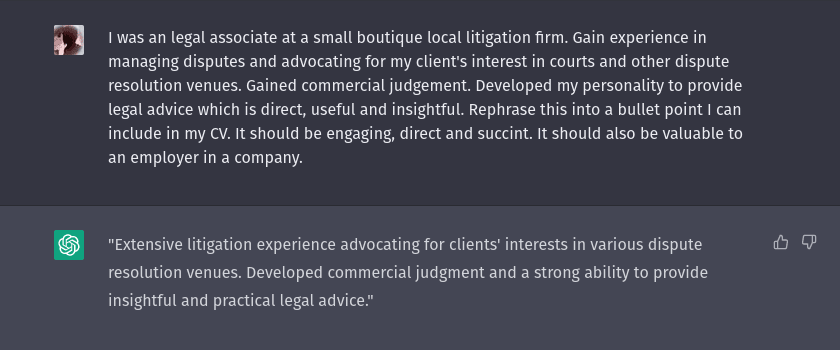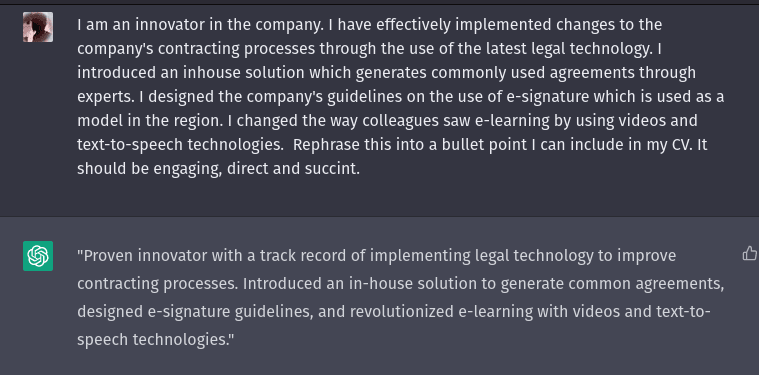Let ChatGPT take over your resume
I explain how to use #ChatGPT to write resumes, including finding a template, directing the model to produce bullet points, and summarizing experiences. The article highlights the benefits of using ChatGPT and provides tips for using the tool effectively.
If you are an introvert like me, writing a #resume or a curriculum vitae (#CV) must be one of the most irritating chores. Unfortunately, it’s integral to finding a new job and opening new opportunities. In this post, I try to save myself from this nonsense by getting ChatGPT to do it for me instead. Once you see how easy and effective it can be, you’d probably never want to do it on your own again.
Why should we do it?
Most people do it to save time. This makes sense because writing a CV consists primarily of two parts. First, consider what you have done in your professional life so far. Second, putting that down on paper. The second part requires you to frame that experience in a relevant and succinct way yet allows you to stand out from the competition. Large language models are good at rewriting and aiming for certain tones. So it’s going to help you get the second part down.

The real surprise is that people who use ChatGPT to write resumes seem to succeed in getting their jobs:
The online job site said nearly half of 2,153 job seekers surveyed earlier this month used ChatGPT to help write their resumes, their cover letters, or both, and the majority said it helped them land the job they wanted
This speaks to particular characteristics of ChatGPT and other AI models: they are excellent bullshit artists. But what’s the problem? If you tell a computer to bullshit for you, why should we worry when it’s doing a great job?
The fact is that a lot of people can’t sell themselves even if they need to. Lawyers overrate their ability to write an effective resume; this isn’t oral advocacy or a 50-page appellant’s case they practice often. I can’t bring myself to butter up my work and achievements on a piece of paper. A lack of skill and conviction can bring down your resume.
Let’s do this — Step 1: Find a template.
Unfortunately, ChatGPT is not going to generate a document for you. It’s a large language model, not an expert system, silly!
Most people can dig up their old CVs or resume. If you are new to the working world, you can look up templates on Google or get some nice-looking ones from sites like Canva or good old Microsoft Word.
At this point, you should study the different parts of your resume. The most significant section is your experience if this isn’t your first job. If you’re new, you must probably convert your school activities, hobbies and community service into fashionable skills. Other parts include a summary and a list of skills.
Industries look out for specific attributes. The jurisdictions you are qualified in and the magical “PQE” stat are vital for lawyers. Review other CVs to check if you are missing out on anything. If not, you must “reverse engineer” job postings to ensure you have all the information you need.
The critical point is that ChatGPT doesn’t do any of, or know much about your industry or specific job requirements.
Step 2: Order ChatGPT to write a better CV than you
Here comes #ChatGPT.
The magic of ChatGPT is not that it is a large language model or that it has indexed the vast majority of the world’s information (aka the Internet). There are other large language models, and also Google. ChatGPT allows you to direct the model to generate the language you want using ordinary language or no code. The fancy word for this is “prompt engineering”. By the end of this exercise, you will get a taste of what “prompt engineering” is.
So let’s do some prompt engineering. We will tell the model to listen to our experience, and then produce a succinct version to include in a CV.
… And that’s what we did.

After some experimenting, I found this template useful for producing text to be included in a resume.
[Talk about your experience, hobby, interest etc]
Rephrase this into a bullet point I can include in my CV.
It should be engaging, direct and succinct.
It should also be valuable to an employer in a company.
The prompt is also useful in summarising experiences which are not directly related to your job scope, for example, this one about in-house innovation.

If you aren’t satisfied with the results, you can always tell ChatGPT to try again by regenerating the response. It’s possible to get a different response and one which you might be OK to work with. The ChatGPT interface includes a function to scroll through previous responses, so you can take note of the differences and decide which one you will go with.
If you aren’t happy with what ChatGPT came out with (for example, claiming I “revolutionised e-learning” is a bit too much), you can always directly edit the response yourself.
In the end, I developed a steady and effective process. I would look for a point to fill on my resume, type in what I did in my own words, and then ask ChatGPT to rephrase them for inclusion in my resume. I was grateful I did not have to overthink how to frame my experiences. Simply input it and let ChatGPT do the rest of the work.
Step 3: Order ChatGPT to think highly of you
One of the special features of ChatGPT which isn’t necessarily available in plain large language models is that it remembers your earlier input and its responses. This is a “chat” feature. We don’t need ChatGPT to talk to us, but we can get it to use that information to craft a new response.
For my resume, I need to summarise my experiences into a pithy and impactful paragraph. Time to do some prompt engineering; which again, is me telling ChatGPT what to do.
Based on the information I have given above, write a summary about me which is suitable for a resume.
It should only be a 1 to 3 sentences long.
It should be engaging and attractive to an employer.

Besides paragraphs, ChatGPT is also very good at bullet points. For this exercise, I asked ChatGPT to produce 8 points even though I needed only about 4. Humans will do the selection please, ChatGPT.
Based on the information I have given above,
write a list of 8 points of not more than 3 words each
describing my strengths and expertise succintly.
It should be engaging and attractive to an employer.

Colour me impressed. I have now filled up my CV.
Conclusion
I hope this is a practical roadmap to getting ChatGPT to help you with your #resume. Remember, the purpose of a resume is to get that interview, and you will have to defend your resume then. Telling your prospective employers that ChatGPT was responsible for the rubbish on your resume is not likely going to endear them to you.
If you aren’t looking for a new role, I hope this article gives you a great taste of prompt engineering and how we can use actually use AI in our daily lives. Remember, prompt engineering might be a “dark art” (”If you mispronounce them, demons come to eat you”), but it’s an exciting new field with real opportunities. Till then, continue learning, and continue experimenting.
What will you do with AI today?
Love.Law.Robots. – A blog by Ang Hou Fu
- Discuss... this Post
- If you found this post useful, or like my work, a tip is always appreciated:
- Follow [this blog on the Fediverse]()
- Contact me:

